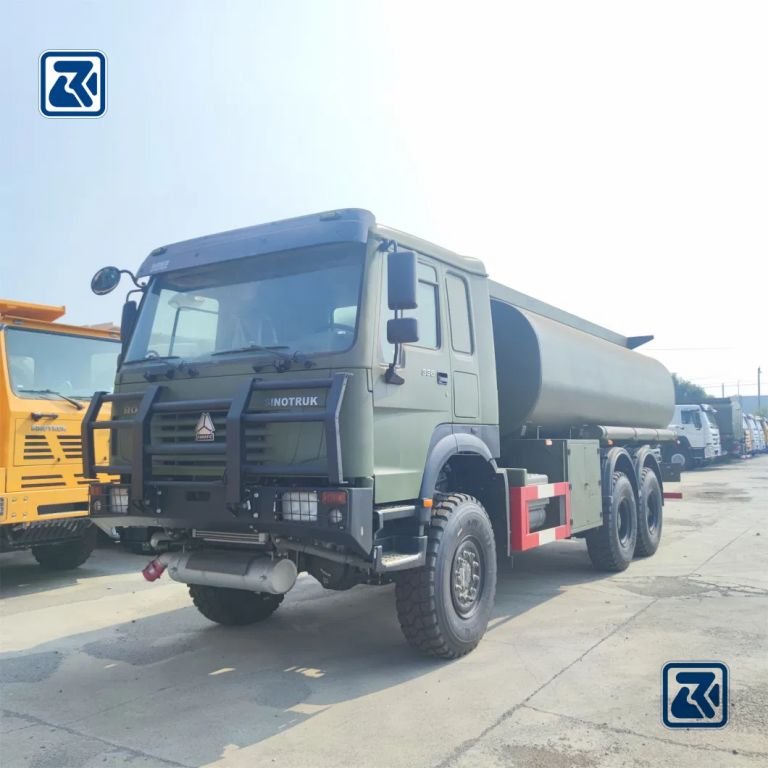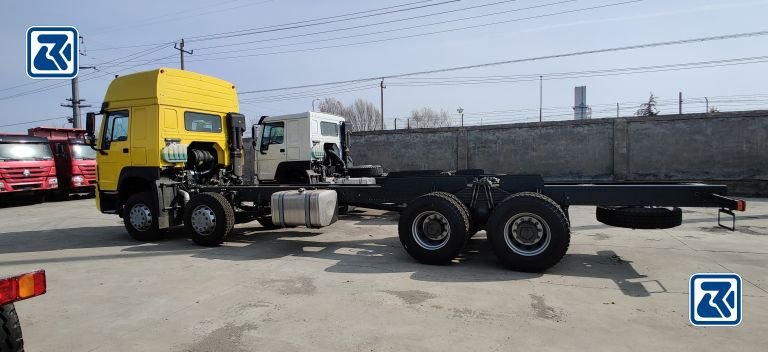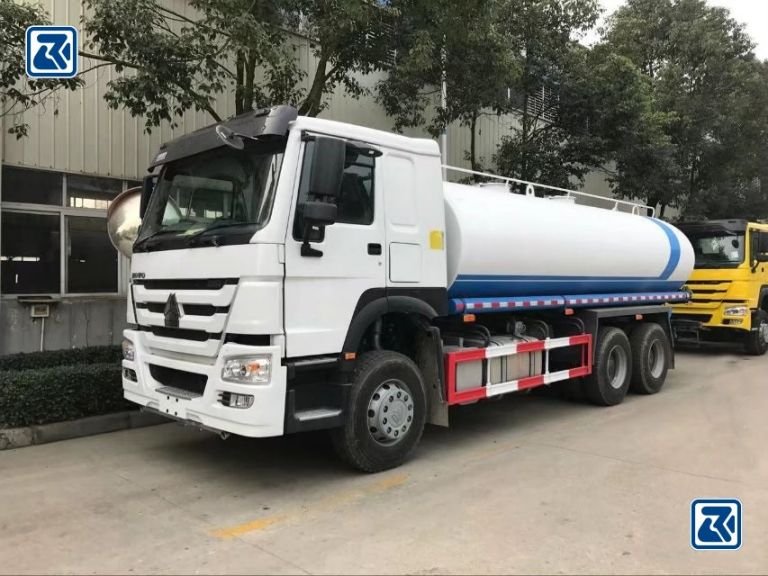Maintaining the hydraulic system of your HOWO tanker truck is critical to ensuring its efficient and safe operation. The hydraulic system is vital to a tanker truck. It helps with loading and unloading fuel. So, its reliability and performance are crucial. Neglecting regular maintenance can lead to system failure. This failure causes costly repairs and safety hazards. Proper maintenance of a HOWO tanker truck’s hydraulic system is essential to ensure operational efficiency and safety. By sticking to a maintenance program, operators can prevent common problems. These include leaks, pressure drops, and component wear. The program will extend equipment life and keep it working well. In this article, we’ll explore best practices for maintaining your HOWO tanker truck’s hydraulic system. They will help keep your vehicle in top shape and ready for any task.
Table of Contents
HOWO tanker hydraulic system
The hydraulic system of the HOWO tank truck is a key component to ensure the smooth operation of various mechanical functions. The system mainly consists of hydraulic oil, pumps, hoses, valves, cylinders, and actuators. The fluid transmits power. The pump generates the pressure to move it. Hoses and valves move the fluid to different parts. Cylinders and actuators turn pressure into force to do tasks. These tasks include lifting, lowering, and tilting the tanker.
The importance of the hydraulic system to the overall function of the tanker truck cannot be overemphasized. It is key in loading and unloading fuel. It allows for precise, controlled maneuvers. These are essential to safe and efficient operations. In addition, the hydraulic system enhances the truck’s maneuverability and stability, ensuring that heavy loads are managed efficiently and safely. Tanker trucks need a well-maintained hydraulic system. Without it, they will struggle to do their vital jobs. This will cause more downtime and higher maintenance costs. It will also create safety risks. So, it’s essential to regularly maintain and inspect hydraulic systems. This keeps tankers in top shape and ensures the safety of the operator and the environment.
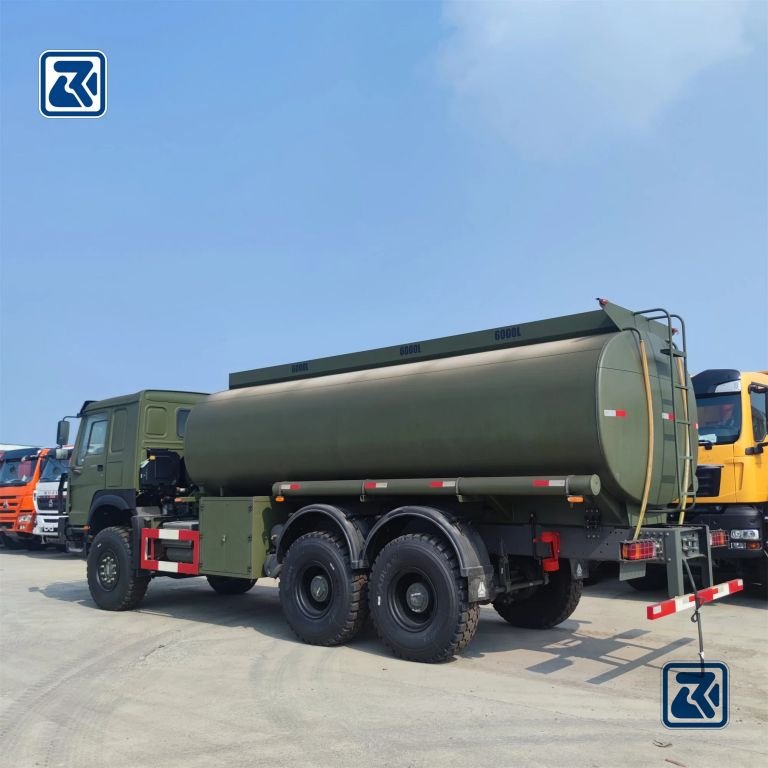
Checking Hydraulic Fluid Levels
Importance of Maintaining Proper Hydraulic Fluid Levels
Keeping the right fluid levels is essential. It keeps HOWO tanker trucks’ hydraulic system working well and lasting long. Hydraulic fluid acts as a medium for power transmission, lubrication, and heat dissipation. Low fluid levels cause increased friction, overheating, and potential damage to the hydraulic parts. This results in lower efficiency and costly repairs. Check the hydraulic fluid levels often. This ensures smooth operation, prevents failures, and lengthens the system’s life.
Step-by-step Guide on How to Check and Refill Hydraulic Fluid
Park the Truck on a Level Surface: Ensure the truck is parked on a level surface and the engine is turned off. This helps get an accurate reading of the hydraulic fluid level.
Locate the Hydraulic Fluid Reservoir: Find the hydraulic fluid reservoir. It is usually near the pump or part of the system.
Clean the Area Around the Reservoir Cap: Wipe the area around the reservoir cap with a clean cloth. This prevents dirt and debris from entering when you open it.
Check the Fluid Level: Remove the reservoir cap or dipstick. If your system has a dipstick, wipe it clean, reinsert it fully, and then remove it again to check the fluid level. If there is a sight glass or level indicator, ensure the fluid is within the recommended range.
Refill Hydraulic Fluid if Necessary: If the fluid level is low, add the recommended hydraulic fluid. Pour slowly to avoid overfilling. Use a funnel to prevent spills and ensure the fluid goes directly into the reservoir.
Replace the Cap Securely: After refilling, replace the cap or dipstick securely to prevent contamination.
Run the Engine and Operate the System: Start the engine and operate the hydraulic system to circulate the fluid. Check for any leaks and ensure the system operates smoothly.
Recheck the Fluid Level: After running the system, turn off the engine. Then, recheck the fluid level to ensure it is still okay. Top off if necessary.
Recommended Types of Hydraulic Fluid for HOWO Tanker Trucks
For HOWO tanker trucks, use high-quality hydraulic fluids. These fluids must meet the specs in the truck’s manual. Commonly recommended types include:
ISO VG 46: A widely used hydraulic fluid that provides excellent performance in a range of operating temperatures.
ISO VG 32: Suitable for colder climates, offering good fluidity at lower temperatures.
AW 68: Provides superior anti-wear properties and is ideal for high-pressure systems.
Always refer to the HOWO tanker truck’s manual. It has specific hydraulic fluid recommendations and specifications. They ensure compatibility and optimal performance. You need to regularly check and add hydraulic fluid to keep your HOWO tanker truck running well.
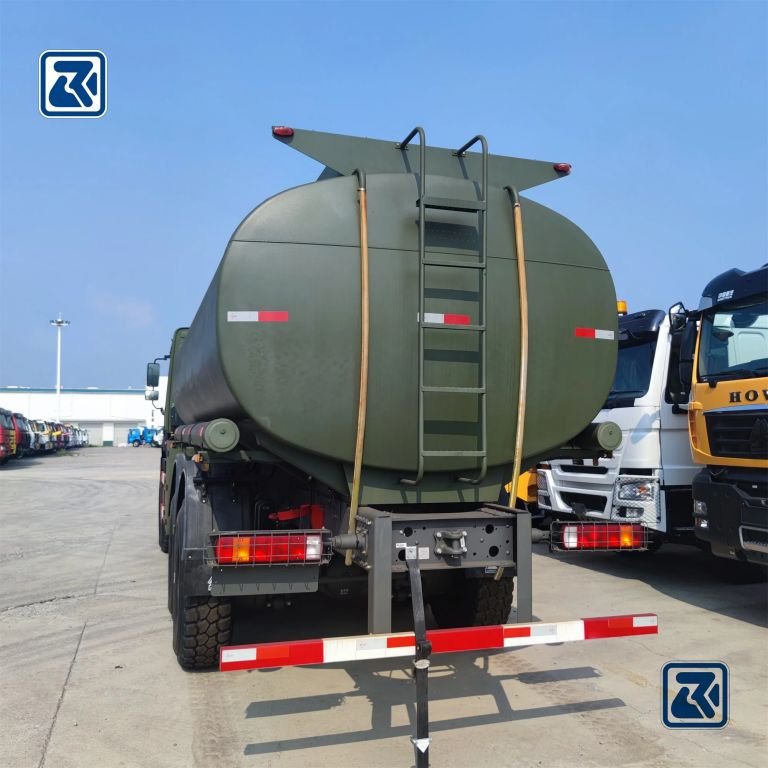
Checking hoses and connections
How to check hydraulic hoses for wear
Checking hydraulic hoses for wear is a critical part of maintaining your HOWO tanker truck’s hydraulic system. Regular inspections help to identify potential problems before they lead to system failure.
Visual inspection: Look for obvious signs of damage such as cracks, abrasions, cuts, or bulges. Focus on areas where hoses are bent or rubbing against other components.
Check for leaks: Check the surface of the hose and surrounding area for signs of hydraulic fluid leakage. Oil stains or wet spots may indicate a potential leak.
Bend the hose: Gently bend the hose to find hidden cracks or weak spots. Be careful not to apply too much force.
Check fittings and couplings: Make sure fittings and couplings are not damaged or corroded. Loose couplings can cause leaks and hose failure.
Importance of checking for leaks and tightening of connections
Checking connections for leaks and tightening is critical. It keeps your hydraulic system leak-free. Loose or broken connections can cause major fluid loss. They also reduce system efficiency and create safety hazards.
Visual and Physical Inspection: Visually inspect connections for signs of leakage, such as fluid stains or moisture. Wipe the connection with a clean cloth and check for fresh oil.
Check tightness: Use a wrench to ensure that all connections are securely tightened. Avoid over-tightening, which can damage threads and seals.
Listen for air leaks: When the system is pressurized, listen for a hissing sound, which may indicate an air or fluid leak.
Steps to Replace Damaged Hoses and Secure Connections
Depressurize the system: Before replacing any hoses, ensure the hydraulic system is fully depressurized. This is to avoid accidents.
Remove the damaged hose: Disconnect the damaged hose from the fitting using the appropriate tools. Be prepared for any fluid that may remain in the hose.
Inspect and clean fittings: Inspect fittings for any signs of wear or damage. Thoroughly clean fittings to ensure proper seal with new hose.
Install the new hose: Install the new hose onto the fitting. Ensure that the hose is the correct length and diameter for the application. Hand tighten the fitting, then secure with a wrench, making sure not to over-tighten.
Check for proper routing: Make sure the hose is routed right. Avoid sharp bends, kinks, and areas where it may rub other parts. Use hose clamps or ties to secure the hose in place if necessary.
Pressurize the system and check for leaks: After installing new hoses, re-pressurize the hydraulic system and check for leaks. Operate the system to ensure that hoses and connections are secure and working properly.
You can maintain your HOWO tanker’s hydraulic system by checking its hoses and connections for wear. Also, make sure all connections are leak-free and tight.

Cleaning the hydraulic system
The benefits of regular system cleaning
There are many benefits to regularly cleaning the hydraulic system on your HOWO tanker truck. By removing contaminants that can cause wear and tear on system components, it helps maintain optimum performance. A clean system runs better. It reduces the risk of overheating and makes hydraulic parts last longer. Also, regular cleaning prevents sludge and debris buildup. They can clog the system and cause it to fail.
How to Safely Clean Hydraulic System Components
Depressurize the system: Before cleaning, make sure the hydraulic system is depressurized. This prevents accidents.
Drain the hydraulic fluid: Carefully drain the existing hydraulic fluid into a suitable container for proper disposal. This step helps remove contaminants and old fluid from the system.
Disassemble Components: Take apart the hydraulic system’s key parts, like filters, hoses, and valves. Do this to access areas where dirt and debris have built up.
Clean Components: Wipe the inside surfaces of the components with a lint-free cloth. For a more thorough cleaning, use a brush to remove stubborn debris.
Flush The System: Flush residual contaminants from the system with the recommended hydraulic system flushing fluid. Follow the manufacturer’s instructions for proper procedure.
Reassembly And Fill: After cleaning, reassemble the components and fill the system with fresh hydraulic fluid. Make sure all connections are secure and free of leaks.
Recommended Cleaning Products and Tools
Hydraulic System Flushing Solution: Use a high-quality hydraulic system flushing solution. It will remove contaminants and sludge without harming system parts.
Lint-free cloth: Use a lint-free cloth to wipe down surfaces and components to prevent the introduction of new contaminants.
Soft Brush: Use a soft brush to clean stubborn debris from hard-to-reach areas without causing damage.
Safety Equipment: Wear proper safety equipment. This includes gloves and goggles. It is to protect you from hydraulic fluids and cleaning agents.
Regular cleaning of the hydraulic system with the right products and tools ensures top performance. It also ensures the long life of the hydraulic parts of your HOWO tank truck.
Troubleshooting Common Hydraulic Issues
Common Hydraulic System Problems and Their Symptoms
You may encounter several common problems with the hydraulic system of your HOWO tanker truck. Each problem has different symptoms. Hydraulic fluid leaks show as oil stains or puddles under the truck. They also show a drop in fluid level. The leaks are usually due to worn seals, cracked hoses, or loose fittings. Overheating problems show high-temperature readings, burnt odors, or fluid discoloration. They are usually due to low fluid levels, dirty fluid, or cooling system failure. You can spot pressure loss by slow operation or less lifting force. It can also cause erratic hydraulic performance. Air in the system, pump wear, or clogged filters can cause it. There are many operating noises, such as whining, knocking, or banging. They come from hydraulic components. They can be caused by air in the hydraulic fluid, cavitation, or worn bearings.
How to Diagnose and Fix These Problems
To find and fix hydraulic fluid leaks, inspect hoses, seals, and fittings for visible damage or wet spots. Replace damaged parts or tighten loose fittings. Check for overheating problems. Look at the hydraulic fluid level and condition. Inspect the cooling system for clogs or damage. Top off or replace the hydraulic fluid as needed. Make sure you use the correct type. Diagnose low pressure by checking fluid levels and for air in the system. Check filters and pumps for wear. Bleed the system to remove air. Or, replace clogged filters and worn pump parts. For noisy operations, listen to strange noises and find their source. Check fluid levels for air bubbles and bleed the system to remove air. Also, inspect and replace worn bearings if needed.
When to Seek Professional Help for Hydraulic System Problems
You can find and fix many hydraulic system problems with regular maintenance. But, some cases need a professional. If the problem persists after troubleshooting, it’s time to consult a professional. This may mean a deeper issue that needs special tools and expertise. These repairs involve hydraulic pumps, control valves, or other critical parts. They should also be done by a professional. This is to ensure the correct diagnosis and repair. If you find a hydraulic problem that could endanger safety, such as a leak or system failure, get professional help right away. If your HOWO tanker truck is under warranty or has a service agreement, professional service ensures compliance. It also keeps the warranty. By spotting common hydraulic problems, diagnosing their causes, and knowing when to seek professional help, you can keep your HOWO tanker truck’s hydraulic system efficient and safe

Conclusion
Regular maintenance is crucial for the hydraulic system in HOWO tanker trucks. It ensures their efficiency and safety. By following best practices, like routine fluid checks and hose inspections, and timely professional servicing, you can prevent system failures. This will also extend the lifespan of your truck. HOWO Special Truck Ltd. provides expert maintenance services and support to help keep your hydraulic system in top condition. Prioritizing hydraulic system maintenance protects your investment. It also ensures the reliable performance of your HOWO tanker truck in tough conditions. This promotes safety and efficiency.
FAQ
You should check the hydraulic fluid level once a week. Also, check it before a long trip. This will ensure good performance and prevent problems.
Common signs include visible fluid leaks, overheating, loss of pressure, slow operation, and odd noises. These noises are whining or knocking. These symptoms indicate the need for immediate inspection and maintenance.
The operator can do basic maintenance tasks. These include checking oil levels, inspecting hoses, and tightening connections. However, a specialist should do more complex repairs and diagnostics. This is to ensure safety and effectiveness.
HOWO Special Truck Ltd offers a full maintenance service. It includes regular inspections, fluid changes, system diagnostics, and repairs. Our expertise ensures that your hydraulic system is kept in optimum condition to improve the performance and life of your tanker.

